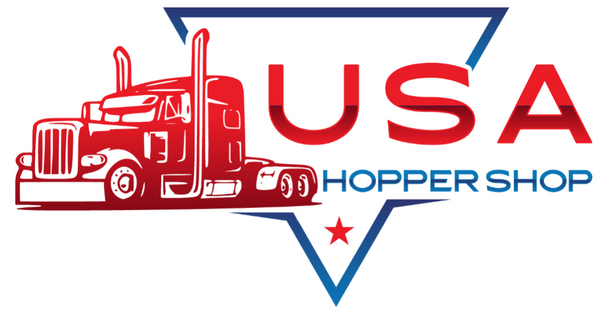
A Guide to Safely Using a Self-Dumping Hopper
Share
When it comes to operating and transporting a self-dumping hopper, safety and efficiency are crucial. That’s why the team at USA Hopper Shop is dedicated to providing facilities with the reliable and safe tools they need to successfully discard waste, scrap materials, and more.
Read on to learn about the safety considerations of operating a self-dumping hopper and everything USA Hopper Shop can provide.
A Brief Overview of Self-Dumping Hoppers
How a Self-Dumping Hopper Works
Self-dumping hoppers are large containers that store and transport bulk materials, trash, and other scrap. These hoppers are designed to attach to a forklift, allowing them to be moved around your jobsite and facilitate the disposal of materials. Once the transportation and dumping are complete, the hopper returns to its upright and locked position.
Benefits of Using a Self-Dumping Hopper
Self-dumping hoppers are built to streamline the material handling process in both industrial and commercial settings. Because of this, there are numerous advantages to using a self-dumping hopper for your project or application needs, with some of the main benefits including:
- Reduced lifting and handling
- Minimized safety hazards
- Controlled dumping
- Improved waste management
Tips for Safely Using a Self-Dumping Hopper
Before Transportation
Prior to moving your materials and debris, properly inspect the hopper for any signs of excess wear or damage. This is especially important for crucial components, such as the latch, base, and drum, that are optimal for successful transportation.
Additional things to keep in mind during the loading process include:
- Securing the forklift with the safety chain
- Inspecting the area to ensure the path of travel is clear of people and obstructions
- Distributing the weight in the hopper evenly to prevent potential tipping during transport
During Use
When you’re ready to transport your materials, make sure to always keep the forks of your forklift spread as widely as possible. Plus, ensure that the latch holder is in the closed position.
Once completed, raise the forks until they reach the necessary height and position for travel. Our team suggests lifting the hopper to the minimum practical height to further enhance the stability of the component, as well as driving the forklift at a moderate speed to prevent sudden weight shifts that could cause the hopper to tip over.
4 General Safety Tips
- Provide training – It’s important to provide all personnel operating the self-dumping hopper and forklift with the proper training needed to complete the task safely and securely. The type of training that individuals receive can depend on the company’s safety procedures, as well as the type of self-dumping hopper and forklift you are using for your application.
- Maintain equipment – Ongoing maintenance of your self-dumping hopper will ensure a maximum lifespan and ease of use. With that in mind, our team recommends regularly lubricating moving parts, cleaning debris from tracks and release mechanisms, and checking the welds and latches for excess wear and cracks for the best results.
- Avoid overloading – Self-dumping hoppers are designed to withstand a specific weight capacity, so exceeding this limit can result in several safety concerns. For example, overloading can increase the risk of mechanical failure and tipping, leading to serious injuries to operators and those in the general vicinity. Plus, overloading the hopper can cause excessive strain to the equipment, which can result in costly repairs and replacements.
- Consider using spotters – Using a spotter while transporting your self-dumping hopper is a great way to enhance visibility and prevent injuries throughout the application process. This is because these individuals are able to deliver clear information to the forklift operator on maneuverability and potential obstacles, among other things.
FAQs About Self-Dumping Hoppers, Our Offerings, and More
How do I prevent the accidental dumping of my hopper?
Proper latching is essential to ensure that your hopper doesn’t dump on its own. So, before and after each use, make sure that the trip lever is fully engaged with the back pad pin. This will help completely latch and secure the open side of your hopper.
Additionally, it’s important to always fasten the safety chain of the hopper to the forklift mast during transport, as well as tilt the mast back to prevent load slippage.
What is the typical weight capacity of a self-dumping hopper?
On average, the total lifting capacity of a self-dumping hopper can range anywhere between 2,000 and 10,000 lb, depending on the intended use and design of the equipment.
How do I know which size hopper I need for my application?
There are a variety of factors that can determine what size self-dumping hopper you would need for the project at hand. These include the:
- Material type being handled
- Available space in your facility
- Volume of the waste you generate
- Weight capacity of the forklift
If you’re looking to learn more about which size hopper is best suited for your application, feel free to reach out to our team directly for more information.
What materials can be stored in a self-dumping hopper?
A vast array of materials can be stored and disposed of in a self-dumping hopper. With the robust capability to carry both heavy and light loads, these components can transport:
- Agricultural products
- Wet materials
- Recyclables
- And more!
What are your hoppers made of?
If you’ve been searching for a reliable, American-made hopper, you’ve come to the right place, as our self-dumping hoppers are comprised of 100% USA Steel. And, to ensure all of our customers can access our trusted products, we’re proud to ship to companies located anywhere in the lower 48 states.
Contact USA Hopper Shop Today
Looking for a self-dumping hopper to accommodate your application? If so, please reach out to our team to get started, as we look forward to assisting you!
